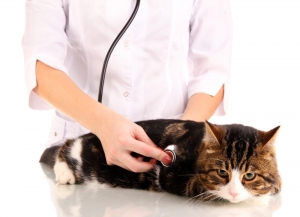Veterinarian Advice: Why It Is Important To Trim Your Pet’s Nails

Why your dog needs regular nail trims.
The clicking sound that you hear when your dog is walking over your wood or time floors of your home is doing far more damage than you realize. When you mention damage that is done by untrimmed dog nails, most people immediately think of scratches on their expensive wood flooring, This is not the most potentially damaging and costly aspect of nail maintenance, and most people are not considering at all the less obvious damage to your dog’s body. Untrimmed nails will often get caught on carpet fibers and other things in your home, potentially tearing the nail from the bed and resulting in a costly and painful trip to the veterinary emergency room. In addition to the immediate potential damage, your dog may actually develop arthritis over time due to the long nails pushing toe bones into un-natural positions. Arthritis and ongoing pain management is costly due to the regular medications that must be administered over time as the dog ages, and there is no cure that will eliminate the problem. Arthritis can be managed with pain medicines but cannot be completely stopped. The growth patterns of dog’s toenails is in a curved shape, meaning that if left completely untrimmed they will curve under the dog’s paws and begin to dig into the skin, causing ongoing pain as they walk. The dew claw is especially prone to this type of problem, becoming ingrown quite easily if left without trimming. Anyone who has ever had an ingrown toenail understands the kind of pain this will cause. Your dog has the same amount of feeling in their paws that you have in your feet and toes. Ingrown toenails hurt them as much as they hurt you. Even worse than this is the fact that dogs actually walk on their toes, and when their toes hurt due to long toenails they begin to compensate by attempting to take weight off them and distribute it to the backs of their paws. This is very much like attempting to walk on your heels all day because you are wearing shoes that are too short, and will usually result in intense backaches, sore muscles and joints, and eventual arthritis over time.
When a dog has longer nails, they are quite prone to ongoing injuries around your home due to being caught on things that your toenails are not. Imagine if your toenails grew in a way the made them hit the floor with every step you took, and they were constantly getting snagged on carpets and other loose fabrics. When you pull your foot away and the nail is caught, the outer enamel of the nail can tear away from the other tissue, exposing the inside of the nail. This is known as the “quick,” which is made up of a fleshy nerve and tissue growing outward from the bone. Keratin surrounds the quick and forms the claw and nail, and the quick is easily injured if is deprived of keratin for any period of time. Infections can form quite quickly and spread to your dog’s foot and blood. Keeping your dog’s nails trimmed short helps to reduce these potential injuries and infections.
Your cat needs regular nail trimming.
Many cat owners do not trim their cat’s nails, even though their veterinarian suggests it. This is because it can be quite difficult to trim your cat’s nails on your own, and additionally people believe that cats maintain their own nails through scratching. This is actually an in correct assumption, and the idea that your cat is scratching things around your home in order to either sharpen their claws or to file their nails down is wrong. Scratching is an instinctual behavior on your cat’s part, and can be quite destructive to your furniture if enough scratching posts and items are not provided. Scratching things around your home is actually your cat marking their territory, due to the fact that they have scent pads in their feet.
The scratching of furniture by pet cats is so destructive in some cases that owners choose to declaw their cats, either as a kitten or after the behaviors starts. This surgery leaves a cat completely defenseless if they are caught outside or are in any type of altercation with another animal. The practice is actually illegal in Europe, and many in the United States want to make it illegal here as well. The solution to this issue is to reduce the cat’s ability to damage furniture by scratching by keeping their nails trimmed short. This will reduce their urge to claw at furniture and curtains, and will also potentially avoid nail damage that can come from getting caught on carpets, screens and loose items. Your cat’s instinct is to pull their foot away if they feel that their toe is caught, which cn result in a painful and costly veterinarian emergency visit.
Rabbits, birds and small animals also need nail trimming
Most people do not realize that birds need to have their nails trimmed, but any veterinarian who specializes in birds or other exotic animals will tell you that if allowed to grow too long, bird can become handicapped by falling from perches. Long nails in birds interferes significantly with a bird’s ability to grasp a perch effectively, and falling from the perch can cause serious injury. In addition, birds who have nails that have been allowed to grow too long and gnarled can easily catch the nail on carpets and loose materials just like dogs and cats, injuring the nail and causing pain and infection if they attempt to pull it away.
Rabbits, guinea pigs and other exotic small pets also need regular mail trimming, just like their larger counterparts, to prevent injuries both to themselves and their owners.
Most pets need regular nail trimming to prevent potential injury, pain and potentially crippling arthritis and joint damage later in life. No matter what kind of pet you own, it makes sense to make nail trimming a regular part of your pet care. It is best to trim your pet’s nails every two weeks of so, either by doing it yourself at home with a nail trimming device you can easily purchase from your local pet store, or by a visit to your veterinarian who will easily take care of the procedure. The cost of regular nail trimming at a local veterinarian will vary from clinic to clinic, usually running from $8 to $15. This is a small price to pay when you consider the large expenses associated with injury or pain management that will accompany a pet that has been neglected in this area. Contact Pet Health Hospital today to arrange your routine nail trimmings for your best friend

 Healthcare in animals is as important as it is in human beings to pay attention to if long and happy life is to be enjoyed, both on the part of the patient as well as the pet parent. What this statement is referring to is the ongoing need to make decisions that are monetary with regards to the wellbeing of your pet, and the mental pain and stress that accompanies those types of decisions. Although insurance plans for pet medications are available, many people do not take advantage of the protections that are offered by a small monthly payment. In large-scale medical events that require expensive surgeries, treatments, and therapies, the decisions to not treat the animal due to out-of-pocket costs, and the eventual suffering or potential death of the pet are decisions that potentially could have been avoided through the maintaining of a small monthly payment. Unfortunately, not nearly enough people choose to protect themselves in this way, leading to poor health and suffering on the part of their pets.
Healthcare in animals is as important as it is in human beings to pay attention to if long and happy life is to be enjoyed, both on the part of the patient as well as the pet parent. What this statement is referring to is the ongoing need to make decisions that are monetary with regards to the wellbeing of your pet, and the mental pain and stress that accompanies those types of decisions. Although insurance plans for pet medications are available, many people do not take advantage of the protections that are offered by a small monthly payment. In large-scale medical events that require expensive surgeries, treatments, and therapies, the decisions to not treat the animal due to out-of-pocket costs, and the eventual suffering or potential death of the pet are decisions that potentially could have been avoided through the maintaining of a small monthly payment. Unfortunately, not nearly enough people choose to protect themselves in this way, leading to poor health and suffering on the part of their pets. There is no doubting the positive health benefits of coconut oil for both pets and for humans, and the benefits themselves can be seen in other articles we have provided on coconut oil, but one question that seems unclear for many people is how to use coconut oil and how much coconut oil should you feed to your pet? This is a pretty easy question to answer, as the general rules for using coconut oil in pet food go by body weight and metabolism. One thing that is very important to consider, however, is getting your pet used to eating the coconut oil in their food. Trying to put a maximum amount into your pet’s food without getting them used to eat it can cause them to feel sick, and potentially get diarrhea or vomiting. For this reason, you will want to make sure that you add the coconut oil to your pet’s food in gradually increasing amounts, over the course of about two weeks. Start with a small amount and work your way up, feeding it to them by mixing it into their regular food each time they eat. The following are the amounts you should feed to your pet:
There is no doubting the positive health benefits of coconut oil for both pets and for humans, and the benefits themselves can be seen in other articles we have provided on coconut oil, but one question that seems unclear for many people is how to use coconut oil and how much coconut oil should you feed to your pet? This is a pretty easy question to answer, as the general rules for using coconut oil in pet food go by body weight and metabolism. One thing that is very important to consider, however, is getting your pet used to eating the coconut oil in their food. Trying to put a maximum amount into your pet’s food without getting them used to eat it can cause them to feel sick, and potentially get diarrhea or vomiting. For this reason, you will want to make sure that you add the coconut oil to your pet’s food in gradually increasing amounts, over the course of about two weeks. Start with a small amount and work your way up, feeding it to them by mixing it into their regular food each time they eat. The following are the amounts you should feed to your pet: